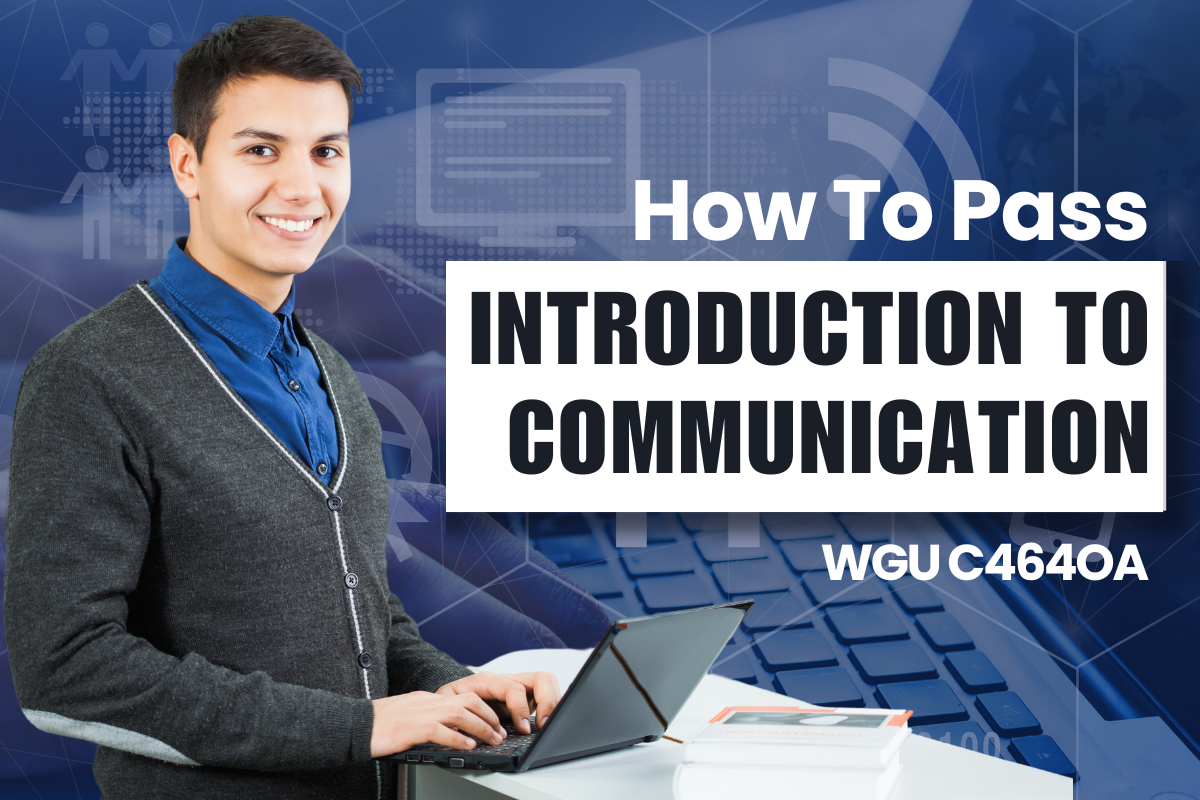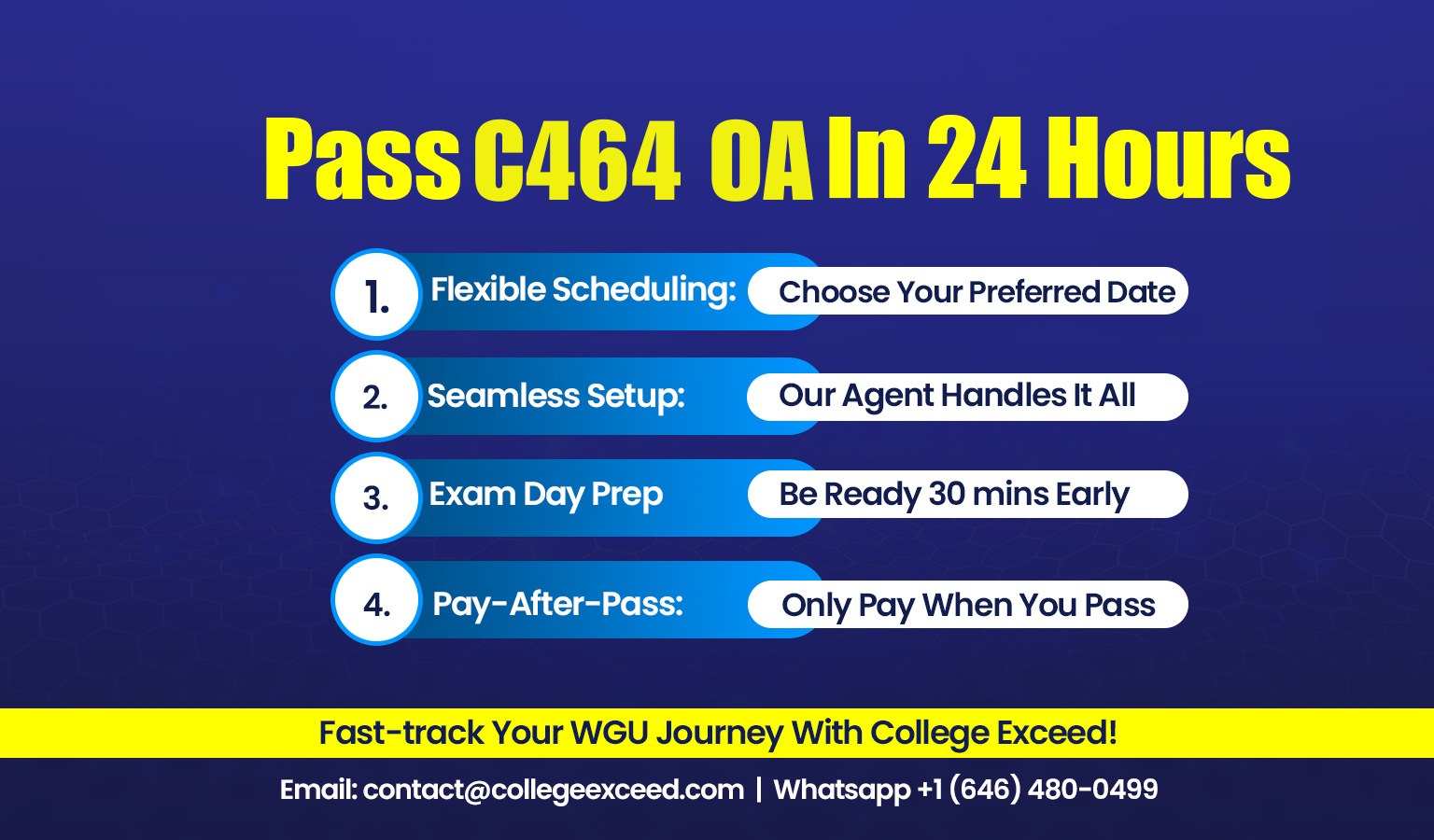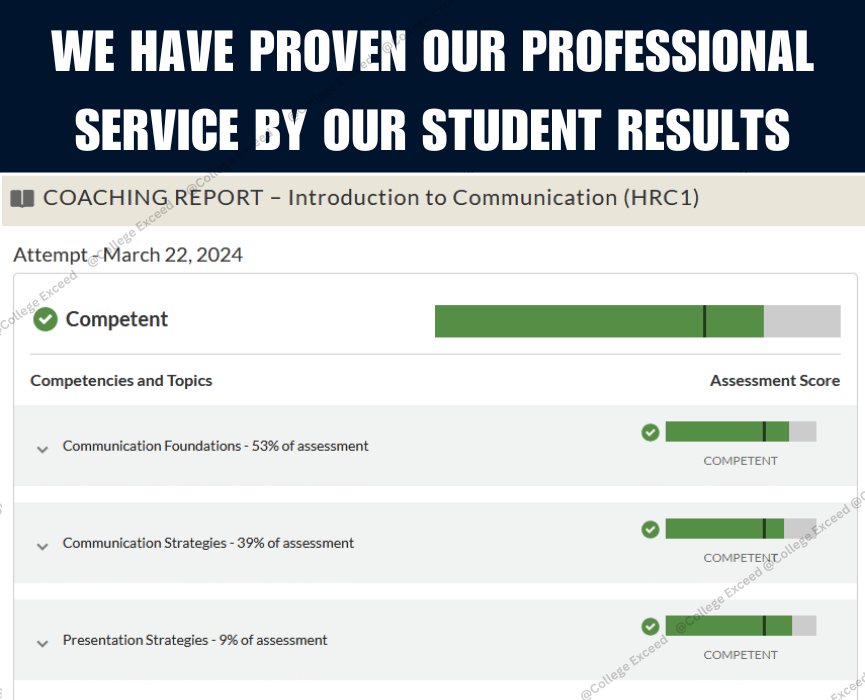Are you a student at Western Governors University (WGU) and you are taking the course Introduction to Communication? If yes, then you might be wondering how to ace the C464 WGU OA (Objective Assessment). you might be feeling a bit overwhelmed by the amount of material and concepts that you need to master for the OA exam. Trust me, I know how you feel! I was in your shoes not too long ago, and I was wondering how I could possibly pass the OA exam and finish the course. Don’t worry, I’m here to help you with some tips and strategies that will make your learning experience easier and more enjoyable. In this blog post, I will share with you:
- A brief overview of the course and its objectives
- A suggested study plan for completing the course in three weeks
- Key topics and concepts that you need to know for the course
- Some external resources and tools that you can use to enhance your learning and prepare for the assessments
- Frequently Asked Questions about the C464
By following this guide, you will be able to master the course content, pass the pre-assessment and the C464 objective assessment, and earn your credit for the course. So, let’s get started!
...
A Brief Overview of WGU C464📖
As you embark on your journey through the “Introduction to Communication” course (WGU C464 OA), you will delve into the core theories and practices essential for effective communication in both personal and professional settings. This module covers a broad spectrum of human communication, offering insights into how we interact at interpersonal, intercultural, and group levels, as well as in public speaking scenarios. You’ll explore how language, perception, culture, and media influence our daily communication, helping you to understand and improve your interactions.
The course is designed to be interactive and engaging, utilizing Acrobatiq’s Introduction to Communication as its primary resource. This platform provides a structured, module-based approach that includes reading materials and practice questions to reinforce your learning. In C464 below topics will be covered.
Topic 1: Basics of Communication
Module 1: Introduction to Human Communication
Module 2: Communication Begins with the Self
Module 3: Culture and Cultural Differences
Module 4: Communication Using Digital Media
Topic 2: Public Speaking and Presentations
Module 5: Goals of a Presentation
Module 6: Informative Versus Persuasive Presentations
Module 7: Giving a Presentation
Module 8: Preparing for a Presentation
Topic 3: Interpersonal Relationships
Module 9: Interpersonal Communication
Module 10: Maintaining Relationships Via Communication
Topic 4 : Listening and Critical Thinking
Module 11: Strategies for Effective Listening
Module 12: Listening and Critical Thinking
Module 13: Verbal and Nonverbal Communication
Topic 5: Team Communication
Module 14: Team Success and Failure
Module 15: Leadership and Power
At the end of each module, you’ll find quizzes that help assess your understanding and readiness for the final exam. Additionally, a pre-assessment is available to gauge your initial grasp of the concepts and identify areas that need more focus, guiding your study efforts more effectively.
Throughout the course, you will not only learn theoretical aspects but also engage in practical exercises, including preparing and delivering an oral presentation. These activities are crucial for developing your communication skills in real-world contexts. Should you need further assistance, course instructors are readily available to help clarify concepts and answer any questions you may have. By the end of the course, you will have developed a more flexible and effective approach to communication, equipped with skills that are valuable in various aspects of life.
Study Guide to Ace the OA📝
Now let us discuss how you can prepare yourself for the ultimate challenge you will face in this module: the OA. We have prepared an in-depth study guide for you to follow and study the course content effectively in the least amount of time to face the challenge head-on. It is important to note that this study guide only prepares you for the OA. The performance assessment will not be a part of this study guide or the article.
Step 1 – Download the note-taking guides provided by WGU
In our research into the study material of C464, we have found that WGU has provided the students with several note-taking guides to assist them keep track of the important concepts of this module. So utilizing these documents will help you track your progress and they will ensure that you will not miss any key points in the topics that will be discussed. So before we dive into the course material, we will download these documents and keep them handy. To download the documents,
Log onto the Student Portal of WGU > Go to the module Introduction to Communication WGU C464 > Go to “Course Search”
In this section, you will be able to see below documents
- C464 Study Guide: Competency 1 (Communication Foundations)
- C464 Study Guide: Competency 2 (Communication Strategies)
- C464 Study Guide: Competency 3 (Presentation Strategies)
Download all three documents and keep them in your desktop.
Step 2 – Go through the Textbook
In step 2 of the study plan, we will start going through the course material. As your first resource for learning the course material, we recommend using the TextBook provided by WGU for the C464 module. This TextBook is important because the questions OA and the Pre-A you will face at the end of this module will be derived from this TextBook only. So understanding the content in this resource will help get the knowledge necessary to face the assessments.
Once you start studying the TextBook, you should pace your studying topic by topic. Concentrate on reading through the topic first, and then attempt the chapter-end quizzes provided for that topic before moving to the next. You may move on to the next topic, only after you completely understand the content you just read. This is important due to the large amount of terms and definitions you will have to memorize to prepare for the OA. Also, make sure to use the Study Guide documents we downloaded previously. These will come in handy later when you need to revise the knowledge before taking the assessments.
Step 3 – Watch the video series on the course content
After you have gone through the entire TextBook and completed taking the notes on the Study Guides, find the video playlist on the course content provided by WGU on the same location mentioned in Step 1,
Log onto the Student Portal of WGU > Go to the module Introduction to Communication WGU C464 > Go to “Course Search”
Once you open the “Course Search” section, browse the pages of the section until you find the below link.
- Course Content Videos for Objective Assessment Review
In this link, you will find a list of videos that will discuss the course content topic by topic. This will give you a chance to revise the knowledge that you have learned in a visual format. With a course instructor presenting the videos, you will be able to get in-depth knowledge of each key concept and also get their input on how each concept will be relevant to the OA. These videos are very engaging and you will be able to go through them in a few hours of your time. So make sure not to skip this step.
Step 4 – Go through the Terms and Definitions
As this module is heavy on theoretical concepts, most of the questions you will face will have you explaining methods/techniques or checking your knowledge of the terms and definitions. Hence it is important to go through the keywords of C464 once again as we are about to attempt the Pre-A in the next step. To do this you can either use the Study Guide notes you have taken previously or find a list of documents provided in the course search that lists down everything you need to memorize. Follow the below-mentioned steps to find the “Course Search” once again to download these documents.
Log onto the Student Portal of WGU > Go to the module Introduction to Communication WGU C464 > Go to “Course Search”
Navigate the pages of this section to find below documents
- C464 Module Notebooks
Step 5 – Go through the Pre-A
Now you are prepared to test your skill in the mock assessment. As you have gone through the course material more than once, you will be more than ready to face the Pre-A and achieve a passing score. So without hesitation find the Pre-A in the WGU C464 module page and try to pass in your first attempt. Remember, when you are going through the Pre-A it is important to treat it as a real exam. This will help you get an accurate understanding of your knowledge before facing the real assessment. This mock assessment will be the last tool we use to ready up for the OA. So make sure you use the same techniques that you will use in a real exam so you can understand your weak points and attend to them.
After you complete the Pre-A, a Coaching report will be automatically generated for you at the same location you found the Pre-A. This report will allow you to get an overview of your knowledge of each topic of C464. Go through this report carefully and find out the topics that you are weak on. Try to revise these topics by visiting your notes and going through the Topic summaries in the TextBook.
If you have failed the Pre-A on your first attempt, work on your weak points and attempt the Pre-A once again. Repeat this process until you achieve more than 80% score on the mock assessment.
Step 6 – Pass the OA
Passing the Pre-A is the only milestone that you need to achieve to know that you are prepared for the OA. First, you should congratulate yourself in your journey in this module so far. You have completed the tedious studying process and now only the final challenge awaits. So without hesitation, schedule the OA as soon as possible and follow the below steps.
- Make sure you have a stable internet connection, a webcam, and a microphone.
- Follow the proctoring instructions and rules carefully.
- Use the same strategies and skills that you used for the Pre-A
- Relax and be confident in your abilities.
Good Luck!!
Key Topics and Concepts of C464🔑
Here we will discuss some key concepts that we have found to be significant in the final assessment. Note that we are only providing you with an overview of these concepts, so make sure to deep dive into these on your own time to understand them in and out. If you require additional resources to study these key concepts, you can find a list of valuable external resources in the next section of this article.
Schultz’s FIRO model
Schultz’s FIRO (Fundamental Interpersonal Relations Orientation) model is a theory that explains how interpersonal interactions and relationships are shaped by three fundamental needs: Inclusion, Control, and Affection. Developed by William Schutz in 1958, the FIRO model provides insights into how people behave in groups and how these needs influence their interactions and relationships. Here’s a brief overview of each component:
Inclusion: This feature refers to becoming a member of the group and letting other people to be part of an activity of one’s. It is an indicator of the degree to which humans are keen on having social existence, acceptance and recognition by other human beings. Social interactions are highly important for people with a high desire for inclusion, while those who have a low desire for inclusion are oriented toward solitude and an intimate circle.
Control: This particular requirement touches upon the need for influence, the desire to be a leader and to exercise responsibility within relationships and groups. It analyzes how much one wants to manipulate others and how much one needs to be manipulated. The above type of personality is characterized by an inclination for command, order, and programme, while the latter type of personality prefers autonomy, independence, and flexibility.
Affection: Consequently, the critical requirement is an urge for social life, companionship, and emotional attachment to other people (Burke, 2012). It constitutes the ability to be with others, find solace, and experience personal closeness. The affection craving constitutes two fundamental aspects. People with a strong need for affection are more inclined to form deep and meaningful relationships and to express their feelings directly, whereas those with a weak need for affection are more likely to maintain formal and distant relationships.
Schutz proposed that these needs influence our behavior and interaction styles in various social settings. Understanding these needs can help individuals and groups improve communication, resolve conflicts, and build stronger, more effective relationships. The FIRO model is often used in organizational development, team-building exercises, and interpersonal skills training to enhance group dynamics and individual self-awareness.
Johari’s Window
Johari’s Window is a psychological tool used to enhance self-awareness, improve interpersonal relationships, and facilitate effective communication. Created by psychologists Joseph Luft and Harrington Ingham in 1955, the model divides personal awareness into four quadrants based on what is known and unknown to oneself and others. Here is a breakdown of each quadrant:
Open Area (Arena): The area of this compass is called your ‘known self.’ This is information about yourself that you know and that other people know, too. It is the external portrait of yourself you portray, consisting of the way you act, behave and feel besides being seen and recognized by others. Effectual communications and relationships that thrive often have a large clear space as understating and honesty lie at the core.
Blind Area (Blind Spot): There you will find things about yourself that others know but you don’t have access to because you are not aware of them. This can be expressed in form of habits, attitudes, or personality traits that are openly seen by you but you are not aware of in yourself. Others’ feedback helps to overcome the deficient side and to boost self-perception.
Hidden Area(Facade): This is the corner that encompasses the knowledge that you have about yourself that you prefer to keep away from others. It is these kinds of things as personal thoughts, feelings or experiences that you will find very hard to reveal. Eliminating the excluded spaces by proper skillful self-disclosure may result in more intimate deeper and truer relationships.
Unknown Area: This is the field of information that is previously unknown to not only you, but to the world. Within it lays inherent talents, invisible feelings or capacities that are yet to open up to be explored by us. Discovery of the previously unexplored area may be a very exciting process and can involve self-exploration, new experiences, and acquiring feedback from other people which, in turn, can lead to personal growth and development.
By using Johari’s Window, individuals and groups can foster better communication and understanding. The model encourages open dialogue, constructive feedback, and self-discovery, all of which contribute to more effective teamwork and stronger interpersonal connections. By expanding the open area and reducing the blind and hidden areas, people can achieve greater self-awareness and improve their interactions with others.
French and Raven’s the six categories of power
French and Raven’s six categories of power describe different ways in which individuals can exert influence over others within organizations and social structures. Developed by social psychologists John R.P. French and Bertram Raven in 1959, these categories provide a framework for understanding the sources and dynamics of power. Here are the six categories:
Legitimate Power: This type of power comes from an official position or role within an organization or social structure. It is based on the authority granted by a formal position, such as a manager, executive, or elected official. People comply with legitimate power out of respect for the authority of the position and the rules that grant it.
Reward Power: Reward power is derived from the ability to provide positive reinforcement or rewards to others. This can include tangible rewards like bonuses, raises, and promotions, or intangible rewards like praise, recognition, and special privileges. Individuals comply with reward power to receive the benefits offered.
Coercive Power: Coercive power is based on the ability to deliver punishments or negative consequences. It involves the use of threats, sanctions, or other forms of punishment to influence behavior. People comply with coercive power to avoid negative outcomes.
Expert Power: Expert power comes from possessing specialized knowledge, skills, or expertise that others value. This type of power is based on the perception that the person has superior knowledge or proficiency in a particular area. People comply with expert power because they trust and rely on the expertise of the individual.
Referent Power: Referent power is derived from the personal characteristics of an individual, such as charisma, likability, and the ability to inspire loyalty and admiration. This type of power is based on the desire of others to identify with or be associated with the person. People comply with referent power because they respect, like, or wish to emulate the individual.
Informational Power: Informational power arises from the possession of valuable information that others need or want. It involves the ability to control access to information or provide insight that others find useful. People comply with informational power because they need or want the information that the individual can provide.
These six categories highlight the diverse ways in which power can be exercised and the different bases on which influence can be built. Understanding these categories can help individuals and leaders use power more effectively and ethically within organizations and social settings.
Monroe’s Motivated Sequence
Monroe’s Motivated Sequence is a five-step persuasive speech framework designed to effectively motivate and influence an audience. Developed by Alan H. Monroe, a professor at Purdue University, this method is widely used in various communication contexts, particularly in public speaking and advertising. The sequence aims to capture the audience’s attention, establish a need, propose a solution, help the audience visualize the benefits, and prompt action. Here are the five steps:
Attention: The first step is to grab the audience’s attention. This can be achieved through a compelling story, a startling fact, a provocative question, or any other attention-getting device. The goal is to make the audience interested and ready to listen.
Need: After capturing attention, the next step is to establish a need or problem that requires a solution. This involves explaining the issue in detail, making it relevant to the audience, and demonstrating its significance. The aim is to create a sense of urgency and concern, showing the audience that the problem affects them and needs to be addressed.
Satisfaction: Once the need is established, the speaker must propose a solution to satisfy the need. This step involves presenting a clear and feasible plan or course of action that addresses the problem. The speaker should explain how the solution works, provide evidence and examples, and address potential objections to ensure the audience understands and believes in the solution.
Visualization: In this step, the speaker helps the audience visualize the positive outcomes of adopting the solution or the negative consequences of not doing so. This can be achieved through vivid descriptions, imagery, and examples that paint a picture of the future. The goal is to make the benefits of the solution tangible and relatable, enhancing the audience’s motivation to act.
Action: The final step is to call the audience to action. This involves specifying what the audience should do next and encouraging them to take immediate steps towards implementing the solution. The speaker should provide clear instructions, emphasize the urgency of taking action, and inspire the audience with a compelling closing statement.
Monroe’s Motivated Sequence is effective because it follows a logical progression that aligns with how people naturally process information and make decisions. By addressing the audience’s needs and emotions, providing a clear solution, and motivating them to act, this method can significantly enhance the persuasive impact of a speech or presentation.
...
External Resources 📂
- Quizzlet #1 – Use this quizzlet as a tool to test your knowledge of this module
- Quizzlet #2 – Find the quizzlets on the communication module and use them to test your knowledge
- Udemy Course – A Udemy course you can use to understand the key concepts of module C464 (Paid Content)
- YouTube Instructor – Go through the videos on this YouTube channel to find valuable information on the key concepts
...
FAQ❓
Q: How is the course structured?
A: The course is divided into modules, each focusing on different aspects of communication. Each module contains text to read, practice questions, and a quiz to assess your mastery of the material. Additionally, there is a pre-assessment available to gauge your initial understanding and identify areas needing more focus.
Q: How can I get help if I have questions or need clarification?
A: Course instructors are available to answer your questions and discuss communication concepts. They can provide additional support and guidance to help you understand the material and succeed in the course.
Q: What is the performance assessment mentioned in the course?
A: The performance assessment is an evaluation component that tests your ability to apply the knowledge and skills learned in the course. While specific details about the performance assessment are not covered in this article, it typically involves demonstrating your communication skills in a practical scenario.
Q: How does this course benefit me?
A: By completing this course, you will develop a well-rounded understanding of various communication contexts and enhance your ability to communicate effectively and confidently. These skills are valuable in both professional and personal settings, helping you build stronger relationships and engage more successfully with others.
...
Conclusion 📄
Mastering the Introduction to Communication course ( WGU C464 ) requires a solid understanding of the fundamental theories and practices covered in this article. By focusing on key concepts such as interpersonal, intercultural, small group, and public communication, you will be well-prepared to ace the Objective Assessment (OA). Utilize the study guide provided and thoroughly read the external resources to reinforce your learning. Engage actively with the interactive modules and practical exercises to enhance your communication skills in real-world contexts. Remember to review and apply the knowledge you’ve gained to ensure a comprehensive understanding of the material. Best of luck in your studies, and may your efforts lead to great success in your final exam!







